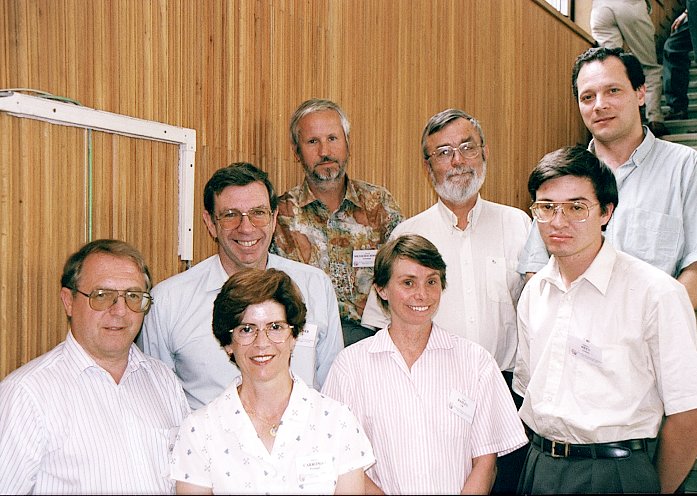 |
Metalloproteins
Chair: Peter Lindley (France), Co-chair: Maria Armenia Carrondo (Portugal)
| C.D. Garner | The Nature of Coordination Sites of Transition Metals in Proteins | A |
| S. Bailey, A.S. McAlpine, A.G. McEwan | Structures of DMSO Reductase, a Molybdopterin Enzyme | A |
| J.C. Fontecilla-Camps, M. Frey, E. Garcin, C. Hatchikian,Y. Montet, C. Piras, X. Vernede, A. Volbeda | Hydrogenases: Hydrogen-Metabolizing Enzymes. What Does Crystallography Tells Us about their Mode of Action ? | A |
| C. Frazao, G,M. Sheldrick, M.A. Carrondo | Cytochrome Structures Determined ab initio: Cytochrome C6 (9.3 KD)and Dimeric Cytochrome C3 (26 KD) | A |
| A.M.W. Messerschmidt, S. de Macedo-Ribeiro, W. Hemrika, R. Renirie, R. Wever | Insight into Vanadium Chemistry in Vanadium Haloperoxidases: X-Ray Structures of Mutants and Functional Derivatives of Chloroperoxidase from Curvularia inaequalis | A |
| S. Rety, J. Sopkova, M. Renouard, S. Tabaries, D. Osterloh, V. Gerke, F. Russo-Marie, A. Lewit-Bentley | Inorganic Ions Influence on Structure of Solution of Human Serum Albumin | A |
 |
A microsymposium on “Metalloproteins” was held on the last afternoon of the ECM meeting and was attended initially by over 90 persons. The chairman, Peter Lindley, (ESRF, France) introduced the microsymposium by pointing out the key roles of metalloproteins in metabolic processes such as photosynthesis, oxydative phosphorylation and nitrogen fixation. He also indicated the opportunities to use a wide variety of diffraction and spectroscopic techniques to investigate the chemistry of the metal centres. These themes were continued by Prof. David Garner (University of Manchester, UK) who pointed out that, “inorganic elements are essential for the normal growth, development and health of living systems”. He also stressed the importance of high resolution macromolecular crystallography in studying the metal centres and the complementarity of X-ray absorption spectroscopy and other spectroscopic techniques. In an elegant review lecture he chose examples of metalloproteins containing Fe, Cu, Ni, Zn, Mo and W and introduced the concept of the Bond Valence Sum rule and a distortion theorem to assist in determining details of the metal coordination. This review lecture was followed by a series of shorter presentations. Firstly Susan Bailey (Daresbury Laboratory, UK) described crystallographic studies on the complex of dimethylsulphoxide (DMSO) with the molybdoenzyme DMSO reductase. This enzyme is an oxotransferase containing a molybdopterin cofactor. It catalyses the reduction of DMSO to dimethylsulphide in a two stage reaction which is linked to oxygen atom transfer and electron transfer. The DMSO was found to bind to the Mo through its oxygen atom and to replace one of the two oxo groups which ligate the oxidised form of the enzyme suggesting that it is this oxygen which is transferred during catalysis
The second half of the symposium was chaired by Maria Carrondo, (ITQB, Portugal). Michel Frey (IBS, Grenoble) described how crystallography was able to determine the mode of action of the hydrogenase, hydrogen metabolising, enzymes. He indicated that the Ni in the [Ni-Fe] centre is most likely responsible for a base-assisted heterolytic cleavage of the hydrogen molecule whereas the iron atom is redox active. Carlos Frazão (ITQB, Portugal) demonstrated the increasing power of modern crystallographic methods by describing the ab initio determination of the structures of a cytochrome c6 and a dimeric cytochrome c3 with molecular weights of 9.3 kDa and 26 kDa respectively. The approach involved the program SHELXD(2) using the half-baked method. Albrecht Messerschmidt (Munich) then described some insights into vanadium chemistry in the vanadium halo-peroxidases. He presented X-ray structural data for various single site mutations of the chloroperoxidase from Curvularia inaequalis and indicated the likely catalytic mechanism based on this structural information and kinetic data. Finally Stephane Réty (LURE, France) described the calcium dependence (or lack of it) of the complex formation between the S100 proteins and the annexins. He detailed a recent structure determination of the P11 protein and its complex with the annexin II N-terminus. The symposium covered a wide variety of metalloproteins and techniques and was accompanied by some 25 poster presentations of high quality. It is to be hoped that similar symposia will be organised for future ECM meetings.
P. Lindley, Chair (ECM-18 report session D8)